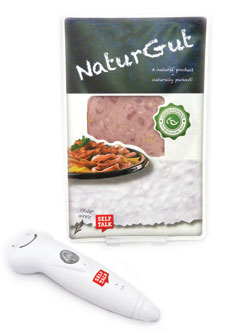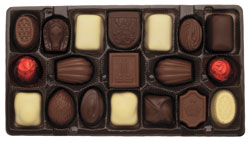Toward the Electronic Food Package
PACKAGING
Today’s passive and emergent active food packaging will gradually give way to interactive if the signals from the electronics universe are accurate forecasters. Hardly a food packaging professional does not link to the virtual infinity of information through devices as primitive as desktop computers or as sophisticated as iPads. What was advanced today—product code readers and recipe retrieval—is careening to obsolescence. Battery operation will capitulate to solar or visible light or even atmospheric microwave radiation to power the packaging. Physical contact sensing will submit to at-a-distance inputs that convert instantly to enable control over the internal package environment. Feedback to consumers will prompt overt action—the interactivity we strive for today, but which will soon be fully automatic.
 The food package is on a highway to positive responsive activity driven by constant measurement of the environment. Distribution channel members will be able to continuously monitor the history and quality of food contents and demand immediate remediation. Loss through spoilage (i.e., food waste) could become a footnote. Consumers will be informed to enable them to optimize acquisition and eating decisions. Just as smartphones, computer-controlled hybrid automobiles, and robotic drones are minimizing the role of operators, so too will electronically driven food packaging optimize food delivery, functionality, and consumption.
The food package is on a highway to positive responsive activity driven by constant measurement of the environment. Distribution channel members will be able to continuously monitor the history and quality of food contents and demand immediate remediation. Loss through spoilage (i.e., food waste) could become a footnote. Consumers will be informed to enable them to optimize acquisition and eating decisions. Just as smartphones, computer-controlled hybrid automobiles, and robotic drones are minimizing the role of operators, so too will electronically driven food packaging optimize food delivery, functionality, and consumption.
Is full automation of food preservation, delivery, and presentation necessarily beneficial for all? How much should we invest in the infrastructure and the envelope itself to upgrade passive barrier to interactive? Before we convert to packaging dominating food’s pleasure, satiation, and nutritional functions, the dialogue over the issues will have been lengthy.
Packaging Power
Passive food packaging that contains readable elements is not common, but it exists commercially. Interactive packaging in which components generate signals are imminent. But these systems must somehow be powered. Batteries engender a cost that food packages cannot afford. Solar energy has been a source for many years, with recent efforts ramped up to attempt to obviate the consumption of nonrenewable resources. “Traditional” solar energy conversion has been by silicon-absorbing panels applying multi- and monocrystalline silicon technologies, knowing that silicon is a weak light energy absorber. Newer forms of light energy absorbers that are more efficient (and economical) include amorphous (i.e., spontaneously arranged silicon, cadmium telluride, and copper indium gallium selenide capable of 20% efficiency level in thin film).
Semprius (www.semprius.com) has developed solar panels capable of converting 34% of incident light energy into electricity. Semprius employs high-concentration photovoltaic module design that begins with micro transfer printing to produce panels of about 600 μm long by 10 μm thick. Cells are grown on gallium arsenide wafers and lifted off. Power production is maximized by placing the cells under glass lenses to concentrate the incident radiation 1,000 times but absent of heat that otherwise must be dissipated.
Denmark’s Technical University Energy Conservation and Storage Department has developed roll-to-roll printable organic photovoltaic energy cells using printed Clevios™ PEDOT:PSS (www.heraeus.com), a highly conductive substituted polythiophene ionomer complex polymer dispersion that functions as an electrode in a layer stack of flexible film. PETDOT:PSS can be applied as an aqueous dispersion and is capable of functioning with silver-based light-emitting diodes, adding yet another dimension to its food packaging potential functionality.
Although these materials are engineered to generate high electrical power, their very size and current efficiency strongly suggest their potential applicability to power interactivity on food packaging in the foreseeable future.
Thinfilm Update
The exploits of ThinFilm Electronics (www.thinfilms.com), which announced Thinfilm memory cards, which the company claims are validations of commercialization of printed electronics, have been previously reported in this column. Among the latest features is high volume, roll-to-roll memory printing using dual layer protection, die cutting, and label conversion of printed memory roll compatible with standard label application equipment, and automated application of memory labels to cards.
Deterioration Detection
Numerous devices have claimed to sense one or more adverse changes in food safety and quality by technologies such as odor absorption, antibody-antigen reactions, weight of microorganisms, and/or electrical conductivity; few of them have fulfilled their promise. This year in the Netherlands, Eindoven University (www.project-cosmic.eu) announced development of a plastic analog-to-digital converter (ADC) to integrate a series of related relevant sensor signals into a “freshness” indicator. Basically, the printed computer receives multiple sensor signals such as environmental temperature, pH, internal package condition, etc., and integrates the information with known response characteristics of the contained food product such as reaction to temperature and/or reduced oxygen, propensity to foster microbial growth, etc.
The resulting immediate calculation is recorded and generated as a visual or audible signal for response by the distribution channel or possibly even the consumer. The ADC is distinguished from prior “spoilage” sensors by virtue of assembling all relevant events with the sensitivities of the contained product in order to compute conclusive evidence of adverse changes in the contained food product. The developers have asserted that the cost per unit is about one cent, a reasonable figure for packaging of fresh meats or seafood whose quality is presently extremely difficult to determine by rapid sensory methods and which have the potential for pathogenic microbiological growth absent of sensory spoilage signals.
--- PAGE BREAK ---
Loud Packaging
In the wake of objectionable noisy packaging produced by application of polylactic acid film pouch packaging to salty snacks, comes Self Talk, the first talking package from Wipak (www.wipak.com), winner of the 2013 World Star Packaging Award for the achievement. The title is a bit misleading since the system is claimed to be audiovisual, but no description of the visual aspect was visible. Self Talk is based on two-dimensional codes recently developed by LIZBEE™ technology analogous to Kindle and other book readers. The nearly invisible dot code is register printed on images and graphics using special varnish. Consumers point their code scanner at the information area to trigger the voice or music or … signal output. Information such as ingredients or nutrition data are read to the consumer. Nearby point of purchase Self Talk posters can instruct the consumer on how to access the package data. The code scanner is provided by the retailer and returned upon completion of the purchase transaction. On-package information is regularly updated from a centralized server.
Self-Sorting Chocolates
Consumer goods packagers have been exposed to what some might describe as an endless stream of devices based on electronic responses. In the list of food packager needs and desires for the future are retail-ready packaging. It is amazing in 2013 that unitized primary food packages arrive at retail grocery or foodservice facilities in corrugated fiberboard cases or trays and are then decased for individual placement on the shelf. The operator’s job is to simultaneously place the most prominent graphics uniformly to display—a most wasteful application of human energy and brain power. One technique to overcome this task is to design the graphics for 360° display, which is not easy in this era of the requirements for data on the package surface. Another “up and coming” technique is to align the primary packages in the secondary package and place the open case/tray on the shelf.
 But now another treat from the cyber world: “self-sorting” packaging from the United Kingdom’s Benson Group (www.bensongroup.co.uk/), a paperboard folding carton supplier. Although designed for chocolate boxes, the system is said to be applicable to arranging and facing primary packages on retail shelves. This
But now another treat from the cyber world: “self-sorting” packaging from the United Kingdom’s Benson Group (www.bensongroup.co.uk/), a paperboard folding carton supplier. Although designed for chocolate boxes, the system is said to be applicable to arranging and facing primary packages on retail shelves. This
self-sorting technology is not yet commercial. Electro-responsive polymers—not specified—are integral to the primary packaging and would be external to the package. In the instance of chocolate sorting, the consumer would touch the graphic corresponding to the desired piece, and the internal works would transfer the piece to the exit gate. The technology is also said to be capable of controlling dispensing; for example, a ketchup bottle containing three sensors in the closure would signal the bottle the size/volume/weight of the desired quantity of the sauce for delivery to the hamburger/hot dog/French fries. For shelf display, orientation sensors would shuttle the primary packages so that the labels are uniformly displayed.
A Future Driven by Information
Excitement from the rapidly emergent realm of electronics can drive a designer or food packaging technologist into words and pictures of almost pure magic. That any of these imaginative concepts can become real is still conjecture. Consider, however, that the notion of solar power was strictly pilot plant a half generation ago, but today we have solar-powered timepieces and smart phones. Miniaturizing conductive ink graphics to generate audio and/or video signals for conversion on personal computers is here today—soon to be gone to thin film memory banks—ready for reading and understanding. Beyond-barrier is assuredly the role of food packaging tomorrow already being implemented. Sensing, reading, and transmitting timely and accurate information about the food contained is possible and even practical today and probably capable of being the enabler for preparation, waste reduction, and the eternal goal of sustainability.
Heineken Gets Interactive
Screaming and sparking for attention at the Milan Design Show last month was the absolute latest in electronically interactive packaging—the Heineken Ignite beer bottle. A veritable laboratory potpourri of 8 bit microprocessor, eight light emitting diodes spotted over the bottle surface, an accelerometer, and a sound receiver, the bottle literally explodes with light, sparks, and electric sounds when it is shaken, rattled, or rolled. The package vibrates when drinkers say “cheers,” and clink glass, and the contents bubble and swirl synchronously with the local disc jockey’s external musical cues.
That the package is clearly a promotional device has not deterred a design and electronic engineering team from developing a working model to demonstrate that it can indeed actively respond to the external environment and become a nearly living entertainment entity. It might not be functional electronics to a food packaging engineer, but it is certainly an interactive activity for the brew marketer.
 Aaron L. Brody, Ph.D., CFS,
Aaron L. Brody, Ph.D., CFS,
Contributing Editor
President and CEO, Packaging/Brody Inc., Duluth, Ga., and Adjunct Professor, University of Georgia
[email protected]
